The Data Centre UPS Market is estimated to be valued at USD 6.2 billion in 2025 and is projected to reach USD 12.0 billion by 2035, registering a compound annual growth rate (CAGR) of 6.9% over the forecast period.
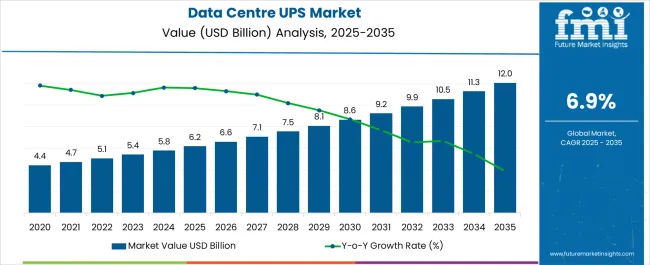
| Metric | Value |
|---|---|
| Data Centre UPS Market Estimated Value in (2025E) | USD 6.2 billion |
| Data Centre UPS Market Forecast Value in (2035F) | USD 12.0 billion |
| Forecast CAGR (2025 to 2035) | 6.9% |
The data centre UPS market is expanding steadily, driven by the rapid growth of digital infrastructure and the increasing reliance on uninterrupted power systems to ensure business continuity. Industry reports and technology company disclosures have highlighted the rising adoption of cloud services, edge computing, and AI-driven applications, which has intensified the demand for resilient UPS systems. Enterprises and hyperscale providers are investing in advanced UPS technologies to mitigate downtime risks, as even minor power interruptions can result in data loss and operational disruption.
Additionally, regulatory frameworks for data security and disaster recovery have reinforced the need for reliable backup power solutions. Manufacturers have been introducing energy-efficient UPS designs that reduce operational costs while aligning with sustainability goals.
Looking forward, growth will be shaped by the rising complexity of data centre workloads, increasing power densities, and the transition to hybrid cloud infrastructures. Segmental momentum is expected to be led by Small UPS systems, Cloud Storage applications, and Double Conversion technology, each addressing critical needs of scalability, reliability, and efficiency in modern data centres.
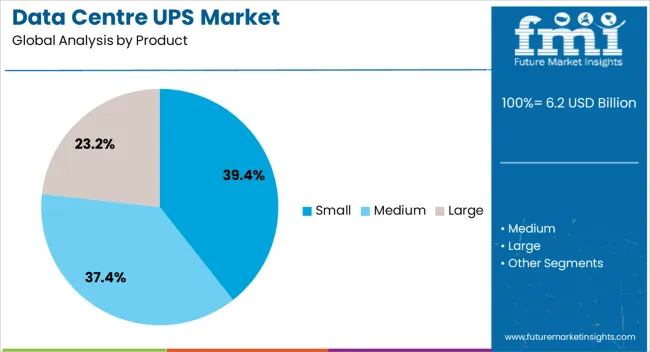
The Small product segment is projected to account for 39.4% of the data centre UPS market revenue in 2025, maintaining its position as the leading product category. Growth in this segment has been driven by the proliferation of edge data centres and small-scale IT facilities that require reliable yet compact UPS systems. Businesses have increasingly invested in smaller UPS units to support localized operations, branch offices, and emerging edge computing networks where space and cost constraints are key considerations.
These systems are valued for their scalability, modularity, and ability to deliver consistent performance for mission-critical applications. Furthermore, the acceleration of digital transformation initiatives among SMEs has amplified demand for small UPS solutions as companies seek dependable protection against power disruptions.
With technological advancements enhancing efficiency and remote monitoring capabilities, the Small product segment is expected to remain dominant in serving the diverse power backup requirements of distributed IT infrastructures.
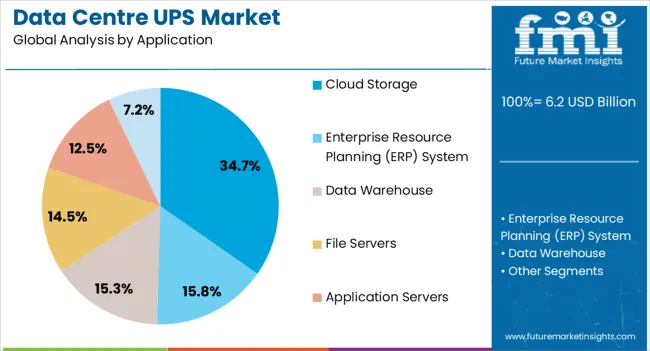
The Cloud Storage segment is projected to contribute 34.7% of the data centre UPS market revenue in 2025, securing its position as the leading application area. Growth of this segment has been supported by the increasing volume of data generated by enterprises, consumers, and connected devices, driving expansion in cloud-based storage solutions. Hyperscale data centres and colocation providers have prioritized UPS investments to ensure uninterrupted access to cloud storage services, as downtime directly impacts customer trust and service-level agreements.
Additionally, the surge in demand for video streaming, digital content, and enterprise collaboration platforms has intensified the requirement for reliable cloud storage infrastructure. UPS systems play a crucial role in safeguarding these workloads against voltage fluctuations and power outages, ensuring operational resilience.
With global enterprises accelerating cloud adoption for scalability and cost-efficiency, the Cloud Storage application segment is expected to retain its leadership, supported by both continuous data growth and increasing reliance on cloud-native business models.
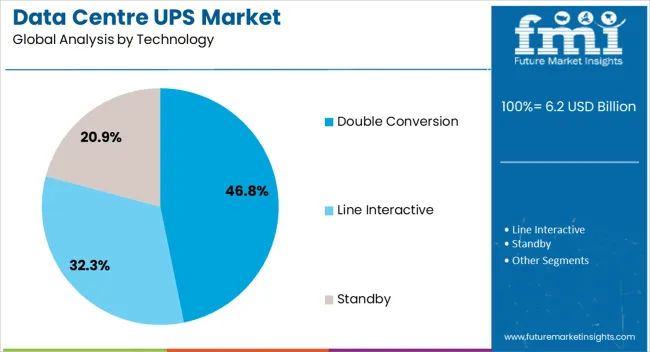
The Double Conversion technology segment is projected to hold 46.8% of the data centre UPS market revenue in 2025, establishing itself as the dominant technology type. This segment’s leadership has been driven by its ability to provide the highest level of power protection by continuously converting incoming AC power to DC and back to AC, eliminating power disturbances. Data centres managing critical workloads have favored double conversion UPS systems due to their unmatched reliability and ability to deliver a consistent, clean power supply under varying grid conditions.
Industry evaluations have emphasized that double conversion systems are essential for protecting sensitive IT equipment against outages, surges, and harmonic distortions. Although these systems are more energy-intensive compared to line-interactive alternatives, technological improvements have reduced their efficiency gap, enhancing adoption.
With the growing importance of mission-critical applications such as AI, big data analytics, and financial services, the Double Conversion technology segment is expected to remain the backbone of UPS deployments in high-performance data centres.
Growing Inclination towards Cloud Computing to Benefit the Centre UPS Market
The rising inclination towards cloud computing, virtualization, and the growing demand for easy data availability is expected to propel the data centre’s uninterrupted power supply (UPS) market during the forecast period.
The rising application of digital services and the prevalence of the digital age or increasing digitization in general especially in the evolving economies will further propel expansion in the data centre uninterrupted power supply (UPS) market. Moreover, concerns regarding the loss of data in case of a power outage will also drive growth in the demand for data centre uninterrupted power supply (UPS).
Cloud computing services are spending about 4.5 times the rate of IT spending. The primary growth of the cloud is due to its availability of about 99% and ease of access. Cloud services need to be online to deliver services that enhance the demand for UPS systems.
High Costs Associated with Raw Materials to Hamper the Market
The most significant factor responsible for hampering the global data centre UPS market is the high expenses associated with raw materials. Further, a lack of expertise and trained personnel will offer a major challenge to the expansion of the data centre-interrupted power supply market.
However, the presence of untapped markets in regions such as the Middle East and Africa, and the growing number of data centres in South America are expected to counter hampering factors and propel the market growth during the forecast period.
Increasing Demand for UPS Systems in SMEs to Augment the Market Size
Growing demand for standby UPS systems among SMEs is expected to offer significant opportunities to the global data centre UPS market during the forecast period.
The associated benefits such as small size, low cost, silent operation when on standby, and greater efficiency have resulted in an increased acceptance of offline UPS among small data centre operators.
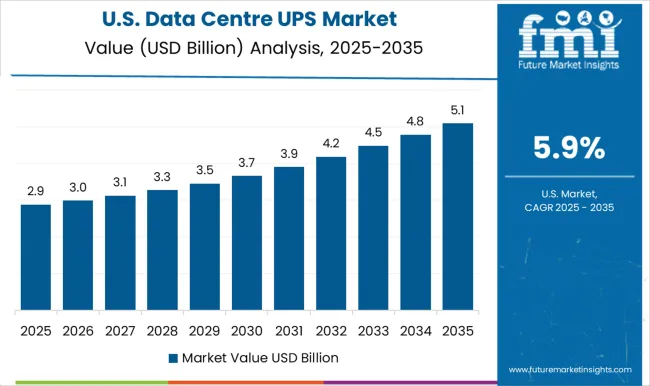
According to the study, the global data centre UPS market is expected to be dominated by North America. In 2025, the region is anticipated to secure 34.7% of the global share. The domination of the region can be attributed to the presence of established firms in the region.
The USA market has a robust presence of various cloud service providers such as Facebook Inc., Delta Electronics Inc., and Google LLC., which are focusing on new strategies to power their data centres. These factors are boosting the industry value of data centre UPS which offers the optimum Power Usage Efficiency (PUE) ratio.
Also, the growing penetration of cloud solutions is expected to benefit the market during the forecast period. As per the World Trade Statistical Review, cloud infrastructure investment in the USA increased by 1.1% in the third quarter of 2024, as the COVID-19 pandemic accelerated the country's digital transition.
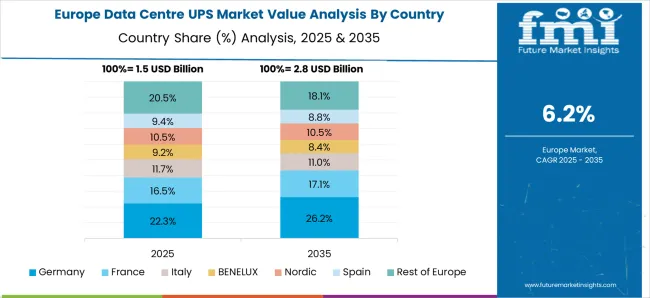
The European market for Data Centre UPS market is expected to be the second-largest market. As of 2025, the region is projected to secure 28.4% of the global share. The development of the region can be attributed to the increasing application of digital payment solutions.
The rising application of contactless payments has grown the demand for data centre UPS that assures reliable power supply. The industry will rise exponentially due to the rising acceptance of these data centre UPS that helps in the maintenance of customer access to online and mobile banking and the operation of trading equipment in large data centre facilities operated by banking and financial institutions.
According to the study, the Asia Pacific is expected to be the fastest-growing market during the forecast period. The growth of the regional market can be attributed to the rapid expansion of the IT & Telecom sector.
The increasing digitization and penetration of technologies like Iota and 5G are expected to play a significant role in driving the global market for data centre UPS market. The telecom operators are introducing a 5G standalone (SA) network to offer modern and advanced services to customers to efficiently run a wireless network that demands a reliable power infrastructure to deliver high-speed services.
In February 2025, Nokia announced the plan to launch advanced services and network solutions for 5G between 2025 and 2025 in India to meet the increasing demand for various industry verticals.
QTS (USA), Vantage Data Centre (USA), Data Bank (USA), structure (Canada), ZoomInfo (USA), Delphix (USA), Oxford Semantic (United Kingdom), Princeton Digital Group (India), and Xplenty (Israel) are some of the emerging names in the global data centre UPS market.
Recent Updates from the Industry:
In February 2025, Data centre company Princeton Digital Group (PDG) announced that it has closed an equity investment of more than USD 500 million led by Mubadala Investment Company, which put in USD 350 million. Both existing shareholders in PDG - Warburg Pincus and Ontario Teachers’ Pension Plan Board - also invested in this round, the company informed.
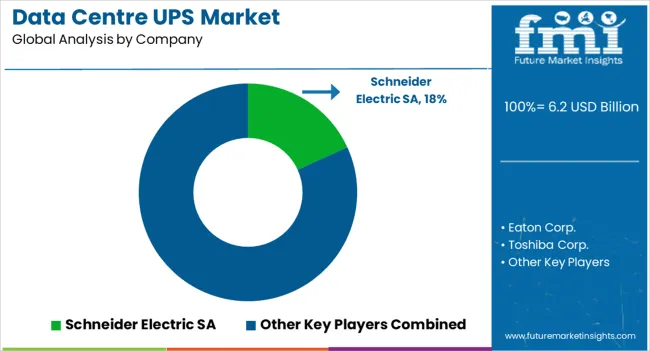
Key players in the global data centre UPSC market include Schneider Electric SA Eaton Corp., Toshiba Corp., Emerson Network Power Inc., Clary Corp., Intellipower Inc., General Electric Electrical Systems, Belkin International Inc., and Power Innovations International Inc.
Key Updates from the Industry Include:
| Attributes | Details |
|---|---|
| Growth Rate | CAGR of 6.9% from 2025 to 2035 |
| Market Value in 2025 | USD 5,407.8 million |
| Market Value in 2035 | USD 10,571.6 ,million |
| Base Year for Estimation | 2025 |
| Historical Data | 2020 to 2025 |
| Forecast Period | 2025 to 2035 |
| Quantitative Units | Revenue in USD million and CAGR from 2025 to 2035 |
| Report Coverage | Revenue Forecast, Volume Forecast, Company Ranking, Competitive Landscape, Growth Factors, Trends, and Pricing Analysis |
| Segments Covered | Product Type, Application, Technology, Region |
| Regions Covered | North America; Latin America; Europe; Asia Pacific; Middle East and Africa |
| Key Countries Profiled | United States of America, Canada, Brazil, Mexico, Germany, United Kingdom, France, Spain, Italy, China, Japan, South Korea, Malaysia, Singapore, Australia, New Zealand, GCC Countries, South Africa, Israel |
| Key Companies Profiled | Schneider Electric SA; Eaton Corp.; Toshiba Corp.; Emerson Network Power Inc.; Clary Corp.; Intellipower Inc.; General Electric Electrical Systems; Belkin International Inc.; Power Innovations International Inc.; Barri; ABB Ltd.; Huawei Technologies; Mitsubishi Electric Corporation; Vertiv Group |
| Customization | Available Upon Request |
The global data centre UPS market is estimated to be valued at USD 6.2 billion in 2025.
The market size for the data centre UPS market is projected to reach USD 12.0 billion by 2035.
The data centre UPS market is expected to grow at a 6.9% CAGR between 2025 and 2035.
The key product types in data centre UPS market are small, medium and large.
In terms of application, cloud storage segment to command 34.7% share in the data centre UPS market in 2025.






Full Research Suite comprises of:
Market outlook & trends analysis
Interviews & case studies
Strategic recommendations
Vendor profiles & capabilities analysis
5-year forecasts
8 regions and 60+ country-level data splits
Market segment data splits
12 months of continuous data updates
DELIVERED AS:
PDF EXCEL ONLINE
Data Center Market Forecast and Outlook 2025 to 2035
DataOps Platform Market Size and Share Forecast Outlook 2025 to 2035
Datacenter Infrastructure Services Market Size and Share Forecast Outlook 2025 to 2035
Data Acquisition Hardware Market Size and Share Forecast Outlook 2025 to 2035
Data Center Automatic Transfer Switches and Switchgears Market Size and Share Forecast Outlook 2025 to 2035
Data Discovery Market Size and Share Forecast Outlook 2025 to 2035
Data Masking Technology Market Size and Share Forecast Outlook 2025 to 2035
Data Center Power Management Industry Analysis in Western Europe Size and Share Forecast Outlook 2025 to 2035
Data Center Power Management Industry Analysis in Korea Size and Share Forecast Outlook 2025 to 2035
Data Center Liquid Cooling Market Size and Share Forecast Outlook 2025 to 2035
Data Business in Oil & Gas Market Size and Share Forecast Outlook 2025 to 2035
Data Lake Market Size and Share Forecast Outlook 2025 to 2035
Data Center RFID Market Size and Share Forecast Outlook 2025 to 2035
Data Center Accelerator Market Size and Share Forecast Outlook 2025 to 2035
Data Lakehouse Market Size and Share Forecast Outlook 2025 to 2035
Data Center Outsourcing Market Size and Share Forecast Outlook 2025 to 2035
Data Center Refrigerant Market Size and Share Forecast Outlook 2025 to 2035
Data Center Fire Detection And Suppression Market Size and Share Forecast Outlook 2025 to 2035
Data Center Security Market Size and Share Forecast Outlook 2025 to 2035
Data Center Construction Market Size and Share Forecast Outlook 2025 to 2035

Thank you!
You will receive an email from our Business Development Manager. Please be sure to check your SPAM/JUNK folder too.
Chat With
MaRIA